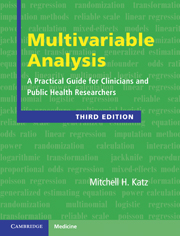Book contents
- Frontmatter
- Contents
- Preface
- 1 Introduction
- 2 Common uses of multivariable models
- 3 Outcome variables in multivariable analysis
- 4 Independent variables in multivariable analysis
- 5 Relationship of independent variables to one another
- 6 Setting up a multivariable analysis
- 7 Performing the analysis
- 8 Interpreting the results
- 9 Delving deeper: Checking the underlying assumptions of the analysis
- 10 Propensity scores
- 11 Correlated observations
- 12 Validation of models
- 13 Special topics
- 14 Publishing your study
- 15 Summary: Steps for constructing a multivariable model
- Index
- References
1 - Introduction
Published online by Cambridge University Press: 01 April 2011
- Frontmatter
- Contents
- Preface
- 1 Introduction
- 2 Common uses of multivariable models
- 3 Outcome variables in multivariable analysis
- 4 Independent variables in multivariable analysis
- 5 Relationship of independent variables to one another
- 6 Setting up a multivariable analysis
- 7 Performing the analysis
- 8 Interpreting the results
- 9 Delving deeper: Checking the underlying assumptions of the analysis
- 10 Propensity scores
- 11 Correlated observations
- 12 Validation of models
- 13 Special topics
- 14 Publishing your study
- 15 Summary: Steps for constructing a multivariable model
- Index
- References
Summary
Why should I do multivariable analysis?
DEFINITION
Multivariable analysis is a tool for determining the relative contributions of different causes to a single event.
We live in a multivariable world. Most events, whether medical, political, social, or personal, have multiple causes. And these causes are related to one another. Multivariable analysis is a statistical tool for determining the relative contributions of different causes to a single event or outcome.
Clinical researchers, in particular, need multivariable analysis because most diseases have multiple causes, and prognosis is usually determined by a large number of factors. Even for those infectious diseases that are known to be caused by a single pathogen, a number of factors affect whether an exposed individual becomes ill, including the characteristics of the pathogen (e.g., virulence of strain), the route of exposure (e.g., respiratory route), the intensity of exposure (e.g., size of inoculum), and the host response (e.g., immunologic defense).
Multivariable analysis allows us to sort out the multifaceted nature of risk factors and their relative contribution to outcome. For example, observational epidemiology has taught us that there are a number of risk factors associated with premature mortality, notably smoking, a sedentary lifestyle, obesity, elevated cholesterol, and hypertension. Note that I did not say that these factors cause premature mortality. Statistics alone cannot prove that a relationship between a risk factor and an outcome are causal.
Information
- Type
- Chapter
- Information
- Multivariable AnalysisA Practical Guide for Clinicians and Public Health Researchers, pp. 1 - 13Publisher: Cambridge University PressPrint publication year: 2011
